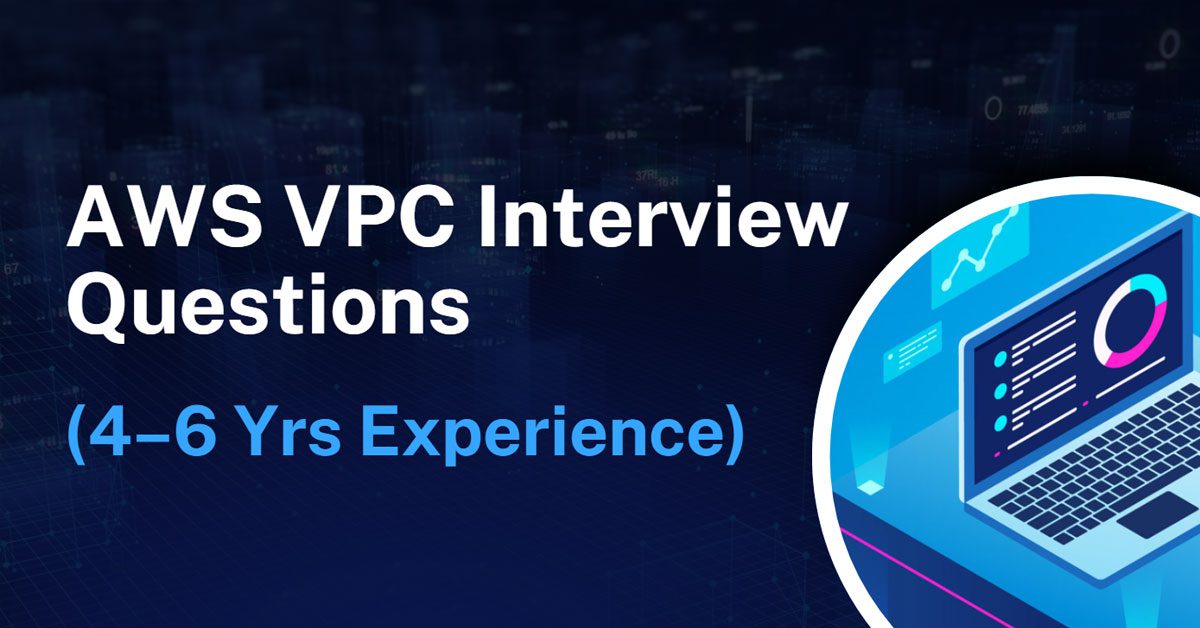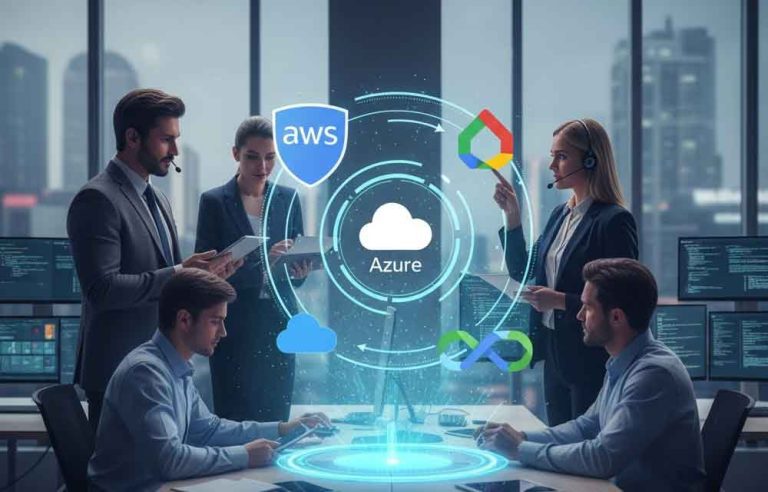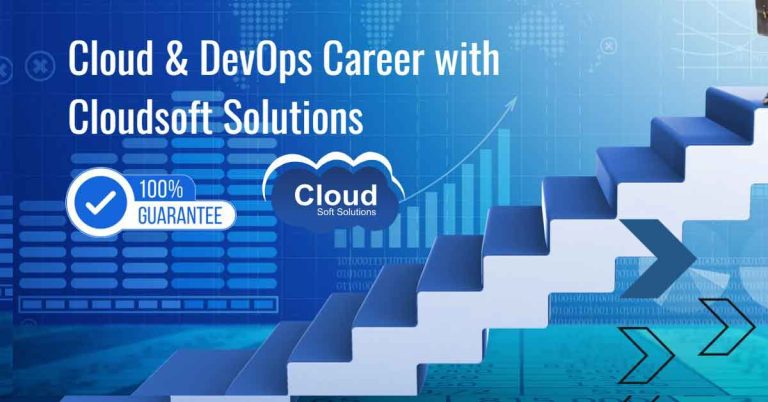VPC Basic to Intermediate Concepts (AWS)
- What is a VPC and why is it needed in AWS?
- What are the key components of a VPC?
- Differentiate between public and private subnets.
- How do you make a subnet public or private?
- What is the difference between a route table and a network ACL?
- How do security groups and NACLs differ?
- What is the CIDR range and how do you plan it in VPC design?
- What is the purpose of an Internet Gateway (IGW)? Can you attach it to multiple VPCs?
Advanced Configuration and Real-Time Scenarios (AWS)
- How would you connect two VPCs? What are the pros and cons of VPC Peering vs Transit Gateway?
- Can you explain how NAT Gateway works? When would you use it?
- Have you configured VPN or Direct Connect in a VPC? What are the use cases?
- How do you secure a VPC to allow access only from a specific IP range or service?
- How would you troubleshoot connectivity issues in a VPC?
- Can a private subnet access the internet? If yes, how?
- Explain how DNS resolution works in a VPC.
Design and Best Practices (AWS)
- How would you design a VPC for a multi-tier application (Web, App, DB)?
- What best practices do you follow for subnetting and IP range planning?
- What is a flow log in VPC? What insights can you gain from it?
- What is the impact of overlapping CIDR blocks in VPC peering?
- How would you design a VPC for high availability and fault tolerance?
Scenario-Based Questions (AWS)
- You are asked to allow external users to access a web app hosted in a private subnet. How would you do it securely?
- A VPC peering connection is established, but traffic is not flowing. What would you check?
- Your NAT Gateway is costing too much. What alternatives would you consider?
- You need to allow your EC2 instances in private subnets to pull data from S3 without going over the internet. How would you achieve that?
- How do you restrict SSH access to only a jump box or bastion host in a VPC?
VNet Security and NSGs (Azure)
- What is a Network Security Group (NSG)? How does it work?
- How are NSGs different from Azure Firewall?
- Where can you associate an NSG in Azure (subnet vs. NIC)?
- What happens if you apply NSGs at both subnet and NIC levels?
- Can NSGs be used to block traffic between subnets? How?
- What are Application Security Groups (ASGs) and how are they used in NSGs?
- Can NSGs be applied to VPN Gateway subnets? Why or why not?
- How do you monitor and troubleshoot denied NSG traffic?
- What is the default behavior of NSG inbound and outbound rules?
- Can you restrict RDP or SSH access using NSGs securely?
Flow Logs (Azure)
- What are Network Watcher Flow Logs in Azure?
- How do flow logs help in troubleshooting and security auditing?
- What are the retention options for flow logs in Azure?
- Can flow logs be integrated with other tools like Log Analytics or Sentinel?
- What is the performance impact of enabling flow logs?
- What is the difference between NSG flow logs version 1 and version 2?
- How would you use flow logs to detect suspicious activity?
- Can you visualize NSG flow logs? If so, how?
- What are common scenarios where flow logs are crucial?
- How do flow logs work with peered VNets?
VNet Peering (Azure)
- What is VNet Peering in Azure and how does it differ from VPN Gateway connections?
- What is the difference between global and regional peering?
- Can you apply NSGs between peered VNets?
- Can you use overlapping IP ranges in VNet peering? Why or why not?
- What happens if you delete a peering connection from one side only?
- What limitations should be considered when planning for transitive peering?
- Can you use custom DNS across peered VNets?
- Is traffic between peered VNets encrypted?
- How does bandwidth cost work in VNet peering?
- Can you peer VNets across different Azure subscriptions or tenants?
Azure Firewall
- What is Azure Firewall? How is it different from NSGs and Application Gateway?
- How do you deploy Azure Firewall in a hub-and-spoke architecture?
- What are Firewall policies and how do they simplify rule management?
- How does threat intelligence-based filtering work in Azure Firewall?
- Can Azure Firewall perform TLS inspection?
- How does Azure Firewall handle DNS filtering?
- What’s the difference between Azure Firewall and a third-party NVA?
- What are NAT and DNAT rules in Azure Firewall?
- Can you use Azure Firewall with Forced Tunneling?
- How do you monitor and log traffic through Azure Firewall?
VPC Security and Network ACLs / Security Groups (AWS)
- What is the difference between Security Groups and Network ACLs in AWS?
- Can you block a specific IP using a Security Group?
- How do you design security for a multi-tier app in a VPC (Web, App, DB)?
- What are the default rules in a Security Group?
- How do you secure your EC2 instances in private subnets?
- What’s the best practice to allow internal traffic between EC2s across different subnets?
- How would you allow only a specific IP to access port 22 of an EC2 instance?
- Can NACLs be stateful? What are the implications of that?
- What would happen if both NACL and SG allow the traffic in, but NACL denies it out?
- How do you control outbound traffic to the internet from private subnets?
VPC Flow Logs (AWS)
- What are VPC Flow Logs and where can they be enabled?
- What kind of traffic can you capture using VPC Flow Logs (accepted, rejected, all)?
- Where can you send Flow Logs – CloudWatch or S3? What are the pros and cons?
- How can you use flow logs to troubleshoot connectivity issues?
- What are the limitations of VPC Flow Logs (e.g., UDP traffic capture)?
- How would you use flow logs to detect a DDoS or scanning attempt?
- What fields are included in a VPC flow log record?
- Can flow logs be enabled at the VPC level?
- Do VPC Flow Logs capture traffic to/from Amazon DNS and VPC endpoints?
- How do you aggregate or visualize VPC Flow Logs for analysis?
VPC Peering (AWS)
- What is VPC Peering? What are its use cases?
- Can peered VPCs communicate across regions?
- What are the limitations of VPC Peering in terms of transitive routing?
- Can two VPCs with overlapping CIDR blocks be peered?
- How do route tables change when peering is configured?
- How do you troubleshoot traffic not flowing between peered VPCs?
- Can you use security groups across peered VPCs?
- How is VPC Peering billed?
- What’s the difference between VPC Peering and Transit Gateway?
- Is VPC Peering encrypted by default?
AWS Network Firewall
- What is AWS Network Firewall and how does it differ from Security Groups and NACLs?
- What are stateful vs stateless rules in AWS Network Firewall?
- How do you deploy AWS Network Firewall in a centralized architecture?
- Can AWS Network Firewall inspect east-west traffic?
- What types of rule groups can you configure in AWS Network Firewall?
- How do you log and monitor traffic using AWS Network Firewall?
- What is the role of Suricata rules in AWS Network Firewall?
- How do you handle TLS traffic inspection with AWS Network Firewall?
- How does AWS Network Firewall integrate with Route Tables and Subnet routing?
- What are the limitations of AWS Network Firewall compared to third-party solutions?
Site-to-Site VPN (AWS)
- What is an AWS Site-to-Site VPN? How is it different from Client VPN?
- What components are needed to establish a Site-to-Site VPN connection?
- What are the two tunnels in a VPN connection used for?
- How does AWS ensure high availability in Site-to-Site VPNs?
- What encryption protocols are used in AWS VPN connections?
- What happens if one VPN tunnel goes down? How do you monitor failover?
- How do you configure BGP vs Static routing in AWS VPN?
- Can you connect multiple on-prem networks to the same VPC via VPN?
- What are the bandwidth and latency considerations for VPN vs Direct Connect?
- How would you troubleshoot a non-working VPN tunnel in AWS?
VPC Endpoints (AWS)
- What is the difference between an Interface Endpoint and a Gateway Endpoint?
- Which AWS services support Gateway Endpoints?
- How do VPC Endpoints enhance security for accessing AWS services?
- Can you use VPC Endpoints to restrict internet access for EC2 instances?
- What is PrivateLink and how does it relate to Interface Endpoints?
- How do you restrict access to an S3 bucket using a VPC Endpoint policy?
- Can you use VPC endpoints across accounts or regions?
- How do DNS names work for Interface Endpoints?
- What are the limitations of VPC Endpoints?
- Can VPC Endpoints be used with Transit Gateway?
AWS Direct Connect
- What is AWS Direct Connect and what are its key use cases?
- What’s the difference between a public and private Direct Connect connection?
- How is Direct Connect different from a Site-to-Site VPN?
- What are Direct Connect Gateway and Virtual Interfaces (VIF)?
- How do you ensure redundancy and failover in Direct Connect?
- What is the minimum bandwidth offered in Direct Connect?
- Can you use Direct Connect for multiple VPCs? How?
- How does billing work with Direct Connect?
- What are the steps to configure Direct Connect from scratch?
- How do you secure your Direct Connect traffic?
AWS Transit Gateway
- What is AWS Transit Gateway and why would you use it?
- How does Transit Gateway improve over traditional VPC peering?
- Can you explain the difference between attachments and route tables in TGW?
- What types of attachments are supported in TGW?
- How would you connect multiple VPCs and an on-prem data center using TGW?
- Can Transit Gateway support multicast traffic?
- How does traffic isolation work with multiple route tables in TGW?
- What are Transit Gateway Connect and TGW VPN attachments?
- What are the throughput limits of a Transit Gateway?
- How do you monitor and log Transit Gateway traffic?





